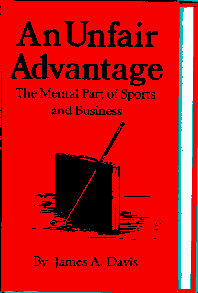Skills for the serious sport enthusiast:
The following sections are from the book: AN UNFAIR ADVANTAGE - The Mental Part of Sports.
Copyright (C) by James A. Davis. Permission is granted to copy and distribute portions of this manuscript as long as the source and the author are properly cited.
Preface
It comes as a shock to me that I've been tinkering with these practices for over
twenty years. As is often true of chemists who begin experimenting in their
basement at an early age, I began playing mental games and doing a variety of
mental manipulations at a young age. I can remember calmly putting iodine on
an open infected blister on my foot at thirteen. Through the use of a mental pain control technique that appeared in the back of a sport magazine, I felt only it as a curious sensation. At the time I wasn't aware of the import of these efforts.
As my youthful affection for psychology grew, I became enthralled by the
then radical formulations of the parapsychologists and even began practicing
telepathy techniques each night as I went to sleep. Unfortunately, psychoanalysis and dream interpretation were the vogue at the time, and they seemed to have the corner on books and available course work. With no ready made and easy outlet for my parapsychology interests, I chose the time honored response of youth and began to drift.
My lack of commitment combined with the pressure of Vietnam and the
draft to land me in the Navy making submarine patrols. The unlikely
environment of the submarine rekindled my interest in mental control - it offered
a challenging stress problem.
The stress on the submarine was particularly difficult to handle. Not only
was there pressure to perform well, but there was no physical escape from the
situation, no walking away from the job at 5 o'clock. In addition to the
confinement, living conditions were cramped, making it a chore, if not
impossible, to exercise and burn off the stress build-up.
As a result of the lack of physical outlets, I developed a system for coping
with stress based on mental strategies and shifts of attitude. The mental
adjustments were especially helpful since there wasn't time or the facilities for
physical stress management techniques.
It wasn't until years later that I appreciated the advantage of handling
stress with strictly mental techniques. I found that when taking critical exams
and playing in highly competitive sporting events, I was able to focus and do
well when the pressure was on. I used the mental strategies to handle my stress
on the spot - a real advantage, since waiting till later to burn off steam and
regain my composure wouldn't help my performance at that moment.
This turned out to be the main advantage of having a purely mental
strategy: I could use it anytime, anywhere, irrespective of physical constraints (whether in a submarine, on the field or in the meeting room).
After getting out of the Navy, I continued to study psychology and began to
find technical names for the practices I had experimented with. Selective
perception, refraining, classical conditioning, anchoring and idiosyncratic motor
cues were some of them. However, the psychology writings never seemed to
prove helpful in critical situations. They seemed either too theoretical to be
applied, or if they did present suggestions, they slipped into generalities like, "just
relax," and "center yourself." Even when I knew what these suggestions meant, I
had difficulty using them quickly and in the midst of turmoil. As a result of these
shortcomings, I continued to expand the more primitive systems I used as a child
and while in the submarine service.
Continuing to look for a more practical approach to performance, I turned to
a study of business psychology where I thought that the no-nonsense attitude of
the business world would prescribe some useful principles. This wasn't the case
however, and instead of easy answers I found enormous diversity in theory and
recommendations. Not that the theories didn't sound good, they just never seemed
to fit my situation.
During that period, a training session with Richard Bandler and John
Grinder exposed me to the works of Milton Erikson, and helped me to realize that
there were ways to accommodate individual differences. Their linguistic analysis
of very complex dynamics seemed to be the missing link in formulating
individual patterns.
Encouraged, I set out to combine my personal experiences with these
additional principles to produce a system for performing that could be adjusted to
fit anyone, and that could be applied on command. This book is an attempt to
present the results in a usable form.
The principles presented here will give you a strategy to use anytime you
need to perform. Since others don't have a comparable guide, you gain what
might be considered an unfair advantage.
The book is designed so you can turn directly to the areas you are most
concerned with. To make this easier, Chapter 1 provides a description of the
various sections and techniques. Feel free to select and focus on the techniques
you can use today.
|
 Finding Your Groove
Finding Your Groove
 Finding Your Groove
Finding Your Groove
